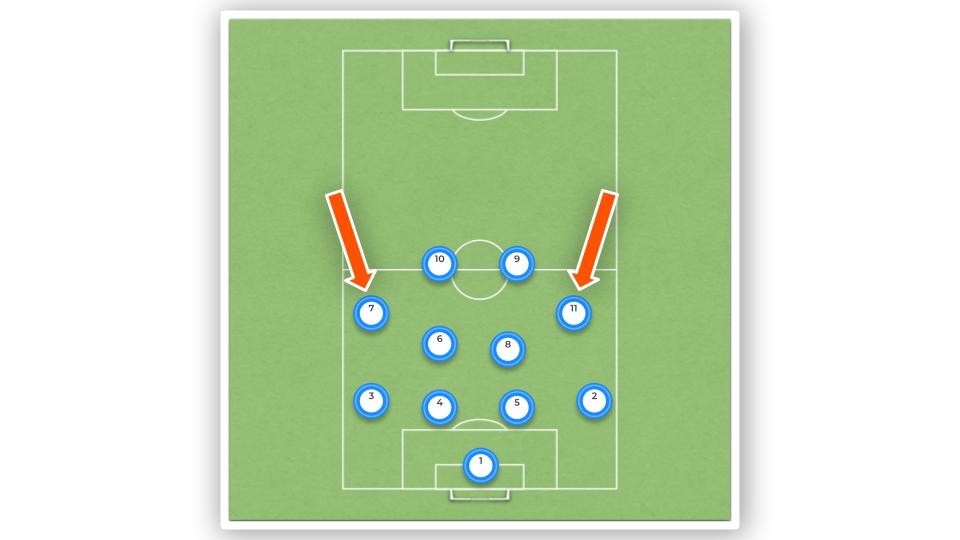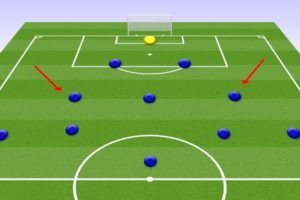Winger in Soccer – Learn the Role of the Winger Position in Soccer
Have you ever wondered what it’s like to be a winger in soccer? It takes skill, determination and technique to excel in this role on the pitch. The winger is an important position that requires special attention — so let’s take a closer look at how they are used and why they are essential for success! In this article, we’ll explore the techniques of wingers in soccer, their specific responsibilities and advantages, as well as strategies for mastering these skills.
Winging involves using speed and agility to beat defenders down the line or cut inside with the ball. A successful winger must have excellent dribbling abilities and good decision-making skills. They must also have great passing accuracy when sending crosses into the penalty box and understand how to correctly time their runs. Wingers provide width to their team which allows them more space to attack from out wide. This often creates overloads against one defender which can create scoring opportunities for strikers or midfielders cutting inside.
Finally, wingers must be able to track back quickly if needed in order to support defensive efforts; this helps maintain balance between offense and defense throughout the game. Mastering all of these aspects will help any aspiring winger become an effective part of the team — so let’s dive deeper into each component of being a successful player in this crucial role!
What Is A Winger In Soccer?
In soccer, a winger is often seen as one of the most important players on the field. They occupy a wide attacking position and are usually tasked with providing support to their team’s offense by crossing balls into dangerous areas or taking shots from range. Their role in any given match can be incredibly influential, particularly when it comes to creating goalscoring opportunities for teammates.
The best wingers have an impressive all-round skill set that includes speed, agility, passing ability, dribbling skills and good tactical awareness. They also need to possess excellent technique when it comes to shooting and ball control while having the football intelligence to make effective decisions under pressure. All these attributes combined allow them to create chances out of nothing and take advantage of vulnerabilities within opposition defenses. It’s no surprise then why some of the greatest names in soccer history were wingers!
Role And Responsibilities Of A Winger
When discussing the role of a winger in soccer, it’s important to understand what this position entails. A winger is an attacking player who usually operates near the touchlines and focuses on creating chances while also helping out with defending duties. The responsibilities of a winger can vary depending on their team’s tactics but there are some core elements that every good winger must have:
- The ability to beat opponents one-on-one with dribbling or speed;
- An understanding of when to cross the ball into dangerous areas;
- A willingness to track back and help defend wide areas.
In order for a winger to be successful they need to be comfortable playing both sides of the pitch, as well as being able to recognize how best to exploit space created by teammates. This means having sound decision making skills, knowing when and where to pass, shoot or dribble past players. Depending on their team’s formation, wingers may take upon different roles such as inverted wings which often cut inside looking for goal scoring opportunities rather than staying wide and crossing the ball in. As such, versatility is key for any effective winger. They should always provide width and support defensive actions when necessary while also displaying offensive creativity at opportune moments. Being able to switch between these two aspects quickly becomes essential for any aspiring winger if they want to make it at higher levels of play.
Wingers will always have an impactful presence within any match due to their integral part of most formations and tactics used today in soccer matches worldwide. Their importance cannot be understated as they continue remain one of the most highly sought after positions on the field.
Essential Skills For A Good Winger – What Makes the Best Wingers
The role of a soccer winger is an important one. Statistically, it’s been shown that 70% of goals come from crosses and passes played into the box. As such, being a successful winger requires having a skill set specifically designed to create goal scoring opportunities. It’s a very important soccer position.
Essential skills for a soccer winger include being able to cross the ball accurately, receive the ball in tight spaces, pass the ball with precision and cut inside when necessary. A good winger should also have great pace and agility so they can beat defenders on the outside and move quickly up and down the pitch. Scoring goals is also key; while not their primary responsibility, wingers who are capable of finding the back of the net will be invaluable assets to any team.
TIP: Developing your technical abilities as a soccer winger is essential if you want to succeed at this position. Practice passing drills frequently, work on crossing accuracy regularly, and focus on improving your speed whenever you get out onto the field. It will also pay off to focus on your positioning – have an open body when you’re near the sideline so you can quickly carry the ball. With dedication and hard work, you’ll soon become an invaluable asset for any team!
What Makes A Good Winger?
The right wing is a place of majesty and power. When a soccer player graces the pitch, they have a chance to create something beautiful on the right side. As an attacking player in this position, they can bring life to thousands of fans with a single pass or shot. A good winger has all the tools needed to make magic happen – crossing ability, speed, vision, and creativity.
A great winger takes these skills and brings them together into one powerful package. They must be able to read the game quickly and accurately assess their options when attacking from the wings. Additionally, they need to possess excellent technical ability so that they can deliver precise passes and crosses for teammates up front. Good wingers also understand how important it is to track back defensively when required. This allows them to retain balance between attack and defense on the pitch as well as helping out their team in transition moments during play.
This combination of talent makes good wingers some of the most sought-after players in soccer today because of their unique abilities both on and off the ball. With the strong technique, intuition, and flair, there’s no doubt why teams build around quality wingers who know how to take control of any match situation at hand!
Different Role of a Winger
Have you ever wondered what makes a soccer field complete? The answer lies in the different forms of wingers. Wingers are an important position in soccer, playing wide on either side and often providing the team with width and options to move forward. On the left side of the pitch, we have the classic ‘left winger’ who plays close to the touchline, stretching play towards their opponent’s penalty area. On the right side we may find someone whose role is more focused on dribbling down the flank and crossing into dangerous areas for teammates. Alternatively, these two positions may be combined so that one player will stay out wide while another cuts inside- this can confuse defenders as they don’t know which way to go.
No matter which form they take, good wingers always need to provide defensive cover when needed and make sure they keep their balance between attack and defense. They must also recognize when they should cross or dribble and when they should cut back onto their stronger foot – usually their preferred foot would be used if playing on the left (which many do). Good wingers should possess great ball control, speed over short distances and quick decision-making capabilities too- all of which allow them to deliver quality passes from tight spaces or create opportunities for others by taking players away from goal. Teams can become unstoppable with two solid wingers playing together on opposite sides of the pitch!
The Benefits Of Dribbling As A Soccer Winger
Dribbling is an essential skill for any soccer winger, as it allows them to move the ball quickly and effectively downfield. It’s their primary role on the team: they need to be able to dodge opponents while keeping possession of the ball. This requires great agility, quickness, and technique that can only be developed with a lot of practice.
Having good dribbling skills makes a good winger. They will have more control over the ball when passing or shooting; being able to outrun defenders gives them time to pick out a pass or set up for a shot. Additionally, wingers need to be creative in order to create opportunities for themselves and their teammates. Dribbles are often used by wingers to beat defenders in tight spaces or break away from markers before sending crosses into the box.
TIP: Visualize yourself executing successful dribbles against your opposition – this will help you become better at reading defensive pressure and make decisions faster in game situations!
How To Utilize Crosses As A Soccer Winger
As a soccer winger, one must be able to master the essential skill of utilizing crosses. Just like legendary Manchester United wingers Ryan Giggs and Cristiano Ronaldo, mastering this art is crucial in order to become a top-level player.
Crossing is an integral part of wing play and requires precision, accuracy and creativity – something which can only come with practice. Whether playing on the left wing, or right side of the pitch, it’s important for a winger to have good ball control as they’ll need to make sure that every cross is delivered accurately into the box. Too close to the goalkeeper and it’ll be a waste, too far from the goal and it will be easily defended. A successful cross will mean that there’s more chance of scoring a goal; however, if done incorrectly it could result in possession being lost.
A winger needs to be aware of their style of play when making a cross; whether dribbling down the line before crossing or simply delivering the ball from deep within their half. It’s also necessary for them to read where space is available so they can deliver an accurate pass into those areas. In addition, timing and technique are key elements that mustn’t be overlooked if you want to succeed as a winger. With patience and repetition comes mastery – eventually reaching your goals as well as becoming an influential figure in any team setup!
How To Create Space As A Soccer Winger
When used correctly, creating space can be one of the most powerful tools in any winger’s arsenal. It allows them to get behind defenders and separate from marking players trying to contain them. This can open up passing lanes for teammates or allow them to take shots themselves. Additionally, by looking for opportunities to create space, wingers become more challenging targets for opposing teams which gives their team time and room to work with during possession plays.
Stay close to the touchline and stretch the opponents.
To effectively use this tactic while playing on the wings in soccer, timing is key – a split-second too late could mean missing out on a great opportunity. Wingers must also have good decision-making skills so they know when it’s best to pass rather than shoot or vice versa. Furthermore, having quick feet will help immensely since this will make it easier for them to quickly change directions and throw off their opponents without sacrificing speed or agility. All of these components combined will greatly improve how well a winger performs on the pitch, but above all else, being able to recognize openings in defences is what makes someone a truly great soccer player overall.
How To Take Advantage Of Opposing Wingers
As a winger in soccer, it’s essential to understand how to take advantage of opposing wingers on the field. Knowing when and where to place yourself for maximum success can be difficult; however, with practice and dedication, any player can become one of the great wingers of all time.
When facing an opposing winger, some key strategies will help you gain control and possession of the ball. Firstly, remember your traditional winger role: stay wide near the touchline and use speed to beat defenders. Secondly, look for opportunities by making runs behind defenses – this gives you more chances to score a goal. Finally, always know when to take risks! Taking risks too often may lead to turnovers but if done correctly they can prove extremely beneficial.
Here is a bullet-point list of 3 tips that will help you maximize your effectiveness against other wingers:
- Use your speed and agility to get past defenders quickly
- Make sure you’re looking for offensive opportunities at all times
- Take calculated risks – don’t be afraid to go out of your comfort zone!
These tips should give you an edge over other players on the field so make sure you practice them regularly until they become second nature. With enough practice, mastering how to take advantage of opposition wingers will come naturally and seamlessly fit into your overall game strategy!
The Best Formations For A Soccer Winger
For any soccer team, the primary role of a winger is to provide width and stretch the opposition’s defense.
Almost any traditional four-at-the-back formation that uses width will have two wingers.
Although now a little out of favour in the professional game, the classic 4-4-2 formation lent itself to fast wing play, with many teams using two flying wingers to shape their attack. It should be said, however, that a 4-4-2 can be used with much narrower ‘wide midfielders’ as opposed to touchline-hugging wingers. More defence-minded teams usually use this more compact shape.

The 4-5-1 tends to be used for counter-attacking teams with a big-target striker. In this system, the wingers are required to fulfil a disciplined defensive role until their team wins the ball, then, they can use their pace to spring counterattacks or play off the central striker.
The 4-3-3 formation uses two wide strikers or an inverted winger, rather than traditional wingers, although there are many similarities to the role when it comes to attacking play.

Tips For Wingers On The Soccer Field
Wingers in soccer are some of the most important players on the team. Did you know that according to data from a 2018 study, over 50% of goals by football teams were scored or assisted by wingers? This goes to show just how essential every winger is for their side’s success on the pitch.
The role of a winger is an offensive one and requires both speed and skill as well as tactical awareness. They can provide width and create space for other attacking players through quick runs down either side of the pitch. The best wíngers in the world have these qualities in spades, but what should every winger focus on when playing this position?
First, it’s important to get comfortable with your “weaker foot” – your non-dominant foot. Wingers should be able to use both feet effectively so that they can do things like change direction quickly without losing control of the ball. Additionally, understanding where defenders are located and using body positioning to shield them off from possession is key. Players must also practice dribbling at pace while controlling their speed; this way they’ll be difficult to catch up with during match play scenarios. Finally, it’s always wise to look up field before receiving passes so you can already plan where you’re going next!
Wingers must possess tremendous technical abilities combined with sound decision making if they want to make an impact on their team’s performance. By mastering these tips, any player will become more confident and effective when taking on defensive opponents!
Frequently Asked Questions about Wingers in Soccer
What Are The Most Important Attributes For A Successful Soccer Winger?
The first attribute must not be overlooked is speed – both with and without the ball. A winger needs to have explosive acceleration off the mark, allowing them to gain separation from defenders when running at them with the ball or getting into good goalscoring positions when they don’t have it. They also need agility and balance so they can rapidly change direction while dribbling past opponents or cutting inside onto their stronger foot.
A second key factor is technical ability; being able to pass accurately over short and long distances, shoot effectively with either foot, cross balls accurately into dangerous areas and control passes under pressure all play major roles in unlocking defences and creating goal-scoring opportunities. Good decision-making is another area crucial for success – having awareness of where teammates are positioned on the pitch will enable wingers to make better decisions regarding when to drive forward towards goal or pick out a teammate in space. These four fundamental attributes must be present if someone wants to be considered a quality soccer winger.
What Kind Of Physical Fitness Is Necessary For A Soccer Winger?
A good soccer winger needs to have excellent endurance as they will often run up and down the length of the field multiple times during a match. Strength training is also important so they can hold off defenders when dribbling or shielding their teammates from opponents. Agility drills such as weaving through cones help them move quickly with the ball while balance exercises aid them in controlling it even under pressure. A soccer winger needs to possess top-level reflexes too, allowing them to react more quickly than anyone else on the field.
Physical conditioning isn’t everything though; mental toughness is just as vital for success on the pitch. A soccer winger must remain focused throughout every game, maintaining their composure no matter how intense things get out there.
How Can A Winger Maximize Their Impact On The Game?
As a soccer winger, maximizing impact on the game is essential. With their position often being one of the most influential in determining how play will develop and evolve, it’s important to understand how best to maximize their potential. Here are five key things that can help:
First, having good control over technique is crucial. This means knowing when and where to pass or shoot with precision as well as anticipating opponents’ movements so they can be predicted accordingly. Additionally, agility and speed are invaluable assets for any winger; this allows them to make quick turns and changes of direction to create space for themselves and open up opportunities for teammates.
Another factor that should not be overlooked is physical strength. Holding off defenders while keeping possession of the ball can provide an advantage during counter-attacks or set pieces. Furthermore, stamina plays a vital role in allowing wingers to stay active throughout the match without tiring out too quickly – which could prove costly if they rely on bursts of energy late into games.
Finally, communication skills also come into play here; staying vocal by calling out instructions or pointing out runs from other players ensures everyone on the field remains aware and can make all the difference between success and failure. Combined elements will help improve overall performance significantly, enabling those playing on either side of the pitch to have greater attacking possibilities than ever before!
How Can Wingers Improve Their Technical Ability?
Wingers need to develop their dribbling skills; the better control they have over the ball, the easier it will be for them to beat opponents one-on-one or create space in tight areas. Secondly, accurate passing increases a winger’s tactical awareness and allows them to find teammates with perfect timing and precision. Thirdly, good shooting technique helps wingers make dangerous chances out of nothing by unleashing powerful shots from difficult angles. Finally, developing speed and agility gives wingers an extra edge when attempting take-ons or making runs into space behind defenders.
By honing these four technical aspects of the game – dribbling, passing, shooting and speed – wingers can unlock new levels of creativity and effectiveness in offensive situations. Whether its beating opponents down the line or slipping through balls between centre backs, having strong technical abilities is essential for any successful winger looking to cause havoc on the pitch!
What Are The Differences Between A Wide Midfielder And A Winger?
The primary difference between the two lies in their approach of playing. While wingers usually focus on attacking and creating chances, wide midfielders mostly adopt an all-round strategy – they create opportunities and help out defensively while tracking back. Wingers tend to stay closer to touchlines than wide midfielders, although this largely depends on tactical instructions from coaches. Another distinction revolves around ball control; wingers typically look for passes behind defenders while wide midfielders prefer taking possession at deeper levels and distributing it further downfield.
It is worth noting here that both positions require immense technical skills like dribbling, crossing, shielding, tackling etc., however, the application of each may differ depending upon the role assigned by managers. In order to succeed in either position, players need to be alert and agile with sharp reflexes. After all, winning games requires more than just athleticism – being able to read situations accurately will give any player an edge over others.
Final Thoughts on the Winger Position
To summarize, a successful soccer winger must combine technical ability with physical fitness and tactical awareness. They must have the endurance to run up and down the field for 90 minutes while still having enough energy left in their legs to take on defenders or make key passes when necessary. A good sense of timing is also essential; knowing when to make runs into space or link up play with teammates. Wingers must possess an impressive range of abilities that allow them to contribute both offensively and defensively, almost like a butterfly fluttering around the pitch – creating chaos wherever they go! With practice, dedication and hard work, any aspiring winger can become a valuable asset to their team.






